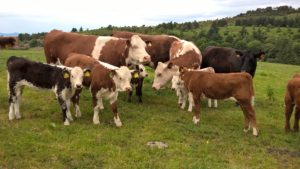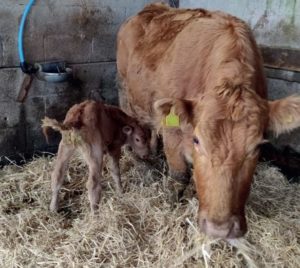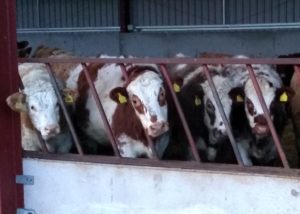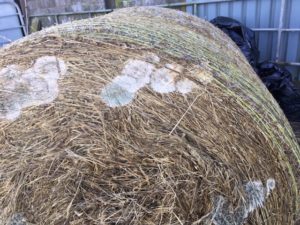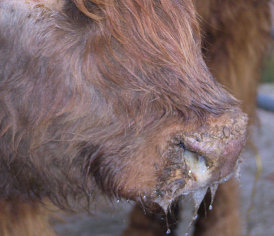Health

Salmonella Dublin in Beef Herds
Although Salmonella Dublin is commonly more associated with dairy herds than suckler herds, problems can still occur, particularly around calving time. On farms, which experience an outbreak, it can have a significant impact on health and mortality during the calving season. Read more >>
Heat Stress At Bulling In Spring Suckler Herds
With temperatures starting to reach 20 degrees plus it is important to make sure that beef cattle have plenty of shade and cool fresh water, especially as many spring calving producers are looking to bull cows currently. Read more>>
Health Considerations Of Youngstock At Summer Grazing
Many producers are preparing to turn cattle out to rented summer grass. Before doing so, it is important to consider the herd health implications when summering youngstock away from home. Read more>>
Preventing Scour In Calves
Calf scour (diarrhoea) is one of the biggest issues associated with illness, poor growth and mortality in calves. The most common causes of calf scour in the first 3 weeks of life are rotavirus and coronavirus (both viral), cryptosporidiosis (parasitic), E.coli (bacterial) and Salmonella (bacterial). An outbreak of infectious scour is costly, in terms of calf losses, treatment costs and labour. Read more>>
Identifying And Treating Lameness In Cattle
There are two vital points to remember when tackling lameness in a group of cattle:
- Identify what the cause of lameness is
- Don’t assume all cases have the same cause
Practical Steps To Reducing Lameness In Finishing Cattle
As with most things in life, when it comes to lameness, prevention is always better than cure. Lameness is recognised as a major issue in the dairy industry, with dairy producers spending a lot of time and money on treating and preventing lameness in their herds. Although not such an acute issue in most beef herds, there is still potential to make changes to reduce lameness, particularly in finishing systems. Read more>>
Nutritional Causes: Focus On Laminitis
Nutritional management has been identified as a key component in the development of laminitis, particularly in rations with a high level of starch resulting in an acidotic state. Therefore, finishing cattle on a high cereal ration or cattle being transitioned onto a high cereal ration are particularly at risk of acidosis which can lead to lameness. Read more>>
Salmonella Dublin In Beef Herds
Salmonella Dublin can cause significant impacts on health and mortality rates during the calving period. However only 10% of the confirmed diagnosis are from beef herds.
It presents itself differently in beef herds compared to dairy herds. Read more>>
Salmonella Dublin - A Risk To The Beef Herd
Salmonella Dublin is a bacterium which more often causes disease in dairy herds than beef herds. However, buying in calves to twin on or rear, or buying beef x dairy replacement heifers can all be sources of risk to the beef herd. Read more>>
Feed Borne Abortions In Spring Calving Beef Herds
A recent two-year study by Tim Geraghty of SRUC Veterinary Services showed that abortions were responsible for 3% of calf losses from PD to weaning in suckler herds in the North East of Scotland. This is a significant loss of potential income to the producer alongside the cost of running a cow empty for the year. Of this 3%, post mortem examinations identified feed borne or environmental agents to be the cause of abortion in the majority of cases. Read more>>
Consider Antibiotic Use This Calving Season
Why? By 2050, antimicrobial resistance is predicted to be the biggest cause of human mortality, exceeding cancer. Reducing dependence on antibiotics is important to preserve their use in human and animal medicine. E-coli, for instance, the bacteria responsible for watery mouth, already has a high resistance to antibiotics on some farms. So, for your livestock and for our fellow human beings, we should seek to reduce antibiotics where possible. Read more>>
Fluke In Fit Cows
Farmers across the country were exposed to a challenging autumn, where rainfall was high and ground conditions were difficult. 2019 year will be remembered for a challenging harvest but also for an abundance of grass. This abundance of grass has led to most cows across the country being in very good (if not too good) condition. With beef prices under extreme pressure and farmers looking for ways to save money, some may look at cow condition and decide not to dose their cows for liver fluke this year. This decision could cost a lot more money than it might save. Read more>>
Managing A Period Of High Grass Staggers Risk
Staggers is caused by cows having a lack of Magnesium and is often fatal to cows, impacting on both animal welfare and business profitability. Here are a few simple steps to reduce the risk of staggers affecting your herd. Read more>>
Winter Housing and Lice
Coming off grass there is the risk that these animals will bring inside with them a burden of parasites. Winter housing is a key time to treat for both external and internal parasites. Read more>>
Lungworm Vigilance
Autumn is a key time for symptoms of lungworm also known as husk or parasitic bronchitis to become apparent. Typically the parasite becomes an issue in late summer through to November with peaks of diagnosed cases in September and October. Read more>>
Abortion In Cattle Due To Bacilus Licheniformis
You may not have heard of it but this bacteria is the most commonly diagnosed cause of abortion in Scottish cattle. SRUC Veterinary Services data shows that over a 10 year period it accounted for one third of all infectious abortion diagnoses. Bacillus licheniformis abortions are most common in housed, pit silage fed, spring calving beef cows in the last 2 months of pregnancy. It can also have a role in still births. Read more>>
Copper: Know Your Limits!
Trace elements play an important role in livestock nutrition and contribute significantly towards health, immunity, growth, fertility and lactation. The functions of many hormones and enzymes are depended on trace elements and therefore they are essential for normal body function. However, care must be taken to ensure that supplementation overcomes any deficiencies in forage but at the same time, the risk of toxicity and exceeding legal limits must be avoided. Read more>>
Tips For Injecting Cattle And Sheep
Bruising, abscesses and trauma are the three main reasons for beef and sheep carcases to be rejected at slaughter. A common cause of abscesses (a collections of pus in confined tissue spaces) is bacterial infection resulting from poor needle practice, particularly in the use of dirty needles. In young stock these abscesses and lesions can stay present from the time of injection until slaughter. Read more>>
Beware Of Summer Pneumonia
Generally this time of year (mid-summer) is a time when suckler farmers relax a little. The stress of calving is over and cows and calves are out at grass however the recent spell of warm and wet weather coupled with the significant temperature differentials between day and night has seen a number of farmers across the country reporting cases summer pneumonia amongst calves. Read more>>
Fly Strike Warning
As the wet weather continues and temperatures start to warm up (creating the ideal conditions for blowfly) there is the increased risk of fly strike among cattle and sheep. Farmers should be on the lookout for the signs of fly strike now as June and July are typically the months when cases peak. Read more>>
Johne's Disease - Do You Know The Risk?
The Johne’s status of a herd is categorised on a Risk Level basis with the lowest level being the best risk level to buy from. This risk level accreditation system means that buyers can see the risk of introducing Johne’s before they buy the animal. Read more>>
Changes To TB Control Measures & Compensation
Changes to disease control measures and compensation for Bovine TB took effect from 12th December 2018. These changes are intended to safeguard the TB controls which are already in place both when purchasing and moving cattle throughout Scotland. Read more>>
Lead Alert
Analysis of SRUC Vet Centre data for the past 5 years shows that 92.5% of lead poisoning cases were diagnosed during the grazing season. Of these almost three quarters occurred in May and June. The time of greatest risk is the period immediately following turn out. The majority involved cattle aged 2 years or less with animals under a year accounting for half. Read more>>
Sign up to the FAS newsletter
Receive updates on news, events and publications from Scotland’s Farm Advisory Service

